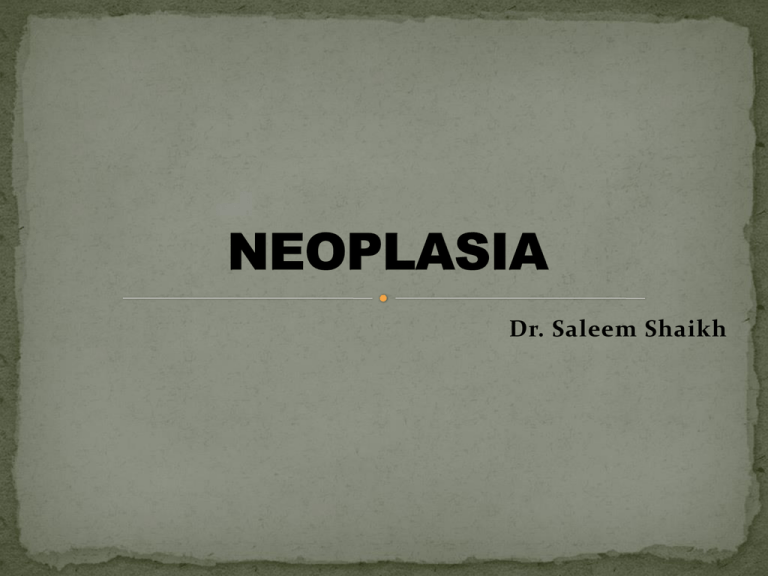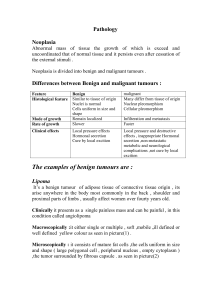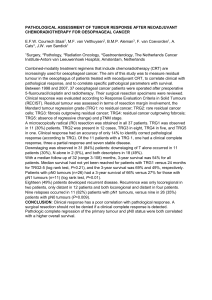neoplasia
advertisement

Dr. Saleem Shaikh “Neoplasia” means new – growth, All new growths can not be grouped under neoplasia, new growth can be seen in embryogenesis, regeneration and repair. Definition: A neoplasm is an abnormal mass of tissue, the growth of which exceeds and is uncoordinated with that of the normal tissue, and persists in the same excessive manner after cessation of the stimulus which evoked the change. The branch of science dealing with the study of neoplasm or tumors is known as ‘Oncology’ Neoplasia is the process, the resulting growth is known as Neoplasm All tumors have two basic components – Parenchyma – comprising of proliferating tumour cells. Parenchyma determines the nature and evolution of the tumour Stroma – composed of fibrous connective tissue and blood vessels, it provides the framework for the tumour cells to grow. Neoplasms may be benign or Malignant Benign – the tumour are slow growing and localised Malignant - when they proliferate rapidly and spread throughout the body. The common term used for all malignant tumours is cancer. The word cancer means crab; “it holds on to the body like a crab” Nomenclature: The tumours are named based on their parenchymal component. The suffix ‘- oma’ is added to benign tumours The malignant tumours of epithelial origin are called as ‘carcinoma’ Malignant tumours of connective tissue origin are named as ‘sarcomas’ Although this nomenclature is applicable to most tumours there are some exceptions Melanoma – carcinoma of melanocytes Hepatoma – carcinoma of hepatocytes Lymphoma – malignant tumour of lymphocytes Leukaemia – malignant tumour of white blood cells Special categories of tumours: Mixed tumours – when two types of tumours are combined in the same tumour it is known as mixed tumour – ex: adenosquamous carcinoma Teratoma: these tumours are made up of various types of tissues, which arise from undifferentiated cells of the three germ layers – most common site is the ovaries and testis Blastomas: also known as embryomas are a group of malignant tumours which arise from embryonal cells. These tumours occur most commonly in children – retinoblastoma Hamartoma: is a benign tumour like growth made up of mature cells of the same tissue and have limited growth potential Choristoma: it is similar to hamartoma in behaviour but the cells are not from the same tissue (ectopic) Majority of the neoplasms are categorised clinically and morphologically into benign and malignant on basis of certain characteristics – 1. Rate of growth 2. Cancer phenotype and stem cells 3. Clinical and gross features 4. Microscopic features 5. Local invasion 6. Metastasis (distant spread) Rate of growth – the tumour cells grow rapidly than normal cells. In general Benign tumours grow slowly and malignant tumours grow rapidly. Rate of production, rate of cell of loss Degree of differentiation of the tumour. Differentiation is defined as the extent of morphological and functional resemblance of parenchymal tumour cells to corresponding normal cells. Poorly differentiated tumours grow more rapidly than the well differetiated tumors. Cancer phenotype and stem cells: Cancer cells escape death signals and achieve immortality Cancer cells perform less or no function Imbalance between cell proliferation and cell death in cancer causes excessive growth Cancer cells arise from stem cells present in the tissues Clinical: Benign tumors are usually asymtomatic and grow slowly, Freely movable, more often firm and uniform. Malignant tumors grow rapidly, may ulcerate the surface and invade into deeper tissues. Haemorrhage and ulceration seen more often. Gross features: Benign tumours are generally spherical or ovoid in shape, encapsulated or well circumscribed. Malignant tumours are irregular in shape. Poorly circumscibed and extend into adjacent tissues. Microscopic features: microscopic characteristics of a tumour are of great importance in recognising and classifying tumours. the features which are seen are : 1. microscopic pattern – epithelial or mesenchymal in origin 2. Cytomorphology of neoplastic cells – differentiation and Anaplasia 3. tumour angiogenesis and stroma – in order to provide nutrition to the growing cells, new blood vessels are formed from old vessels. the tissue stroma may be excessive or scanty (less), If an epithelial tumour is made up of only parenchymal cells and very less stroma then it is called as MEDULLARY. If there is excessive connective tissue stroma seen in an epithelial tumour then it is called as DESMOPLASTIC. BENIGN Nuclear variation in size and shape minimal Diploid Low mitotic count, normal mitosis Retention of specialisation Structural differentiation retained Organised Functional differentiation usually MALIGNANT Nuclear variation in size and shape minimal to marked, often variable Range of ploidy Low to high mitotic count, abnormal mitosis Loss of specialisation Structural differentiation shows wide range of changes Not organised Functional differentiation often lost





